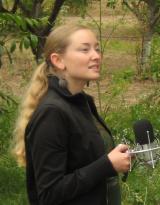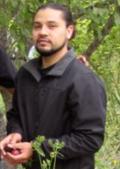![]()
|
Christina Jogoleff & Mauricio Macias |
Listen |
|||
Here is the first part of the conversation in which they introduce themselves and talk about how gleaning fits with their passions for helping their communities in Watsonville. See Part 2 for how their family histories make connections with food, the land, work, and politics. |
[Once the audio is playing, click and drag across the volume bars to change volume. Initial volume set to 80%.] |
|||
|
Connections Rusten set up the conversation by foregrounding connections. |
|
|||
|
Who Are You? The project asks two questions of almost every gleaner who participates in a story session: Though not generally phrased this way, the questions come down to "Who are you?" and "Why gleaning?" |
||||
|
Mauricio foregrounded being a "lifelong student" as well as a teacher, and the importance of owning his Latino identity. |
||||
|
Christina talked about a recently changed identity from worker to student, and touched on her complex heritage, including family ties to the United Farm Workers. |
||||
|
Why Glean? Rusten's second question started asking for connections. |
|
|||
|
Christina learned about gleaning in project member Donna Haraway's class at UCSC. She recognized how much it resonated with the idea of avoiding waste her parents taught her. It also made connections to the deep history her family had with Cesar Chavez and the farm workers. |
||||
|
Mauricio initially came gleaning to support Christina. But he was also interested in how gleaning as a way of reclaiming wasted food worked and how it might become part of connections he was making with communities of Watsonville, the youth he works with, the local geography, and the complex global webs food ties us to. |
||||
|
First Glean Rusten asked about how going to their first glean had changed their thinking about gleaning. |
| |||
|
Mauricio pointed to an initial reluctance, even suspicion. Although those have lessened somewhat, he remains very aware of the limitations of gleaning organized through a large growers' organization like Ag Against Hunger for connecting his Watsonville communities to surplus food, local growers, and farmworkers. Still, he likes the physical act of gleaning and the good it can do. |
||||
|
The first glean surprised Christina: the hairnets, gloves, and knives. She soon settled in with a family of four who were also new to gleaning, sharing the work and sharing stories. Sharing the onions (and later, other gleaned crops) in their neighborhood, has earned Christina and Mauricio the somewhat bemused but affectionate name "The Gleaners". |
||||
|
Brown Berets One of the first connections Christina and Mauricio thought of between Watsonville and gleaning was to see if the Brown Berets might be interested in making gleaning part of their work. Rusten asked them to talk about how that happened. |
|
|||
|
Christina started with their interest in getting younger folks from Watsonville involved in gleaning and in getting a more diverse and representative group of gleaners in the fields. She works with one of the Brown Berets, Ramiro Medrano, at Pajaro Valley HS, and knew about The Bike Shack (a Brown Berets project to get free bikes to farmworkers and to teach folks how to repair their own bikes) and their connections with youth and farmworkers. Ramiro encouraged them to bring the idea to a Brown Berets meeting, where they encountered some suspicion, particularly about Lakeside Organics, which was to be the site of the next glean. Mauricio talked about how his background with community groups in the San Diego area made him think of ways gleaning might help make new connections in the community, not least around food and nutrition. |
||||
|
Gleaning and the Watsonville Community Ramiro and two of his friends did come gleaning. You can hear some of their comments at the May 16th glean. But they didn't return. Rusten asked about whether the Brown Berets might still make gleaning (if not with Ag Against Hunger) part of their programs. That started a long, rich conversation about gleaning, the status of field work and field workers among youth, and how gleaning (as a practice and as an idea) might make new positive connections in and around Watsonville. |
|
|||
|
Christina and Mauricio talked about their very ambivalent reactions to one of the uses Ramiro suggested for gleaning: showing youth how hard field work is as a way of pushing them in other directions. Christina described this as "mocking" field work, and they both lamented how the use of such "scare tactics" (in schools and around the community) can rob field work of its dignity and cut off a powerful way of making connections. Christina and Mauricio both have a very expansive sense of the connections gleaning can make. They've taken their gleaned produce around the neighborhood and in to work, often receiving something in return (fresh organic coffee, for example!) as they talk up gleaning, trying to get more folks out to the gleans. For them, gleaning is a way of being in touch with food and the land in direct ways and even of providing a way to think, for example, about poverty, community, and global food production. Mauricio says he's been reminded of the verb "pepenar" in Mexican Spanish (often translated "gathering" or "scrounging") that describes the practice (less common now than it once was) of gleaning. And he reminded Christina of one of her students who started a garden in an abandoned plot at Pajaro Valley High School and tried to get the school to grow its own food for the students. |
||||
|
For students who work in the fields during the summer, gleaning, says Christina, is a hard sell. In this short fragment, she talks about how hard it is to convince them that gleaning could be fun. |
||||
|
Go to Part 2 of this conversation. |
|
![]()
Note: If you have any trouble using the audio buttons on this webpage, please let us know.
![]()

![]()

![]()

Partially Funded by the California Council for the Humanities, UC Santa Cruz, and INTA - TrainingWeal.


